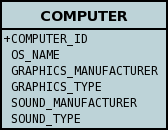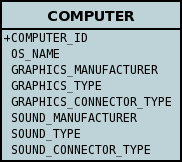
|

|

|

|

|

|

|
|
| DataNucleus AccessPlatform 4.1 Documentation |
|
The JDO persistence strategy typically involves persisting the fields of any class into its own table, and representing any relationships from the fields of that class across to other tables. There are occasions when this is undesirable, maybe due to an existing datastore schema, or because a more convenient datastore model is required. JDO allows the persistence of fields as embedded typically into the same table as the "owning" class.
One important decision when defining objects of a type to be embedded into another type is whether objects of that type will ever be persisted in their own right into their own table, and have an identity. JDO provides a MetaData attribute that you can use to signal this.
<jdo>
<package name="com.mydomain.samples.embedded">
<class name="MyClass" embedded-only="true">
...
</class>
</package>
</jdo>With the above MetaData (using the embedded-only attribute), in our application any objects of the class MyClass cannot be persisted in their own right. They can only be embedded into other objects.
JDO's definition of embedding encompasses several types of fields. These are described below
| Applicable to RDBMS, Excel, OOXML, ODF, HBase, MongoDB, Neo4j, Cassandra, JSON. |
In a typical 1-1 relationship between 2 classes, the 2 classes in the relationship are persisted to their own table, and a foreign key is managed between them. With JDO and DataNucleus you can persist the related persistable object as embedded into the same table. This results in a single table in the datastore rather than one for each of the 2 classes.
Let's take an example. We are modelling a Computer, and in our simple model our Computer has a graphics card and a sound card. So we model these cards using a ComputerCard class. So our classes become
public class Computer
{
private String operatingSystem;
private ComputerCard graphicsCard;
private ComputerCard soundCard;
public Computer(String osName,
ComputerCard graphics,
ComputerCard sound)
{
this.operatingSystem = osName;
this.graphicsCard = graphics;
this.soundCard = sound;
}
...
}
public class ComputerCard
{
public static final int ISA_CARD = 0;
public static final int PCI_CARD = 1;
public static final int AGP_CARD = 2;
private String manufacturer;
private int type;
public ComputerCard(String manufacturer,
int type)
{
this.manufacturer = manufacturer;
this.type = type;
}
...
}The traditional (default) way of persisting these classes would be to have a table to represent each class. So our datastore will look like this

However we decide that we want to persist Computer objects into a table called COMPUTER and we also want to persist the PC cards into the same table. We define our MetaData like this
<jdo>
<package name="com.mydomain.samples.embedded">
<class name="Computer" identity-type="datastore" table="COMPUTER">
<field name="operatingSystem">
<column name="OS_NAME" length="40" jdbc-type="CHAR"/>
</field>
<field name="graphicsCard" persistence-modifier="persistent">
<embedded null-indicator-column="GRAPHICS_MANUFACTURER">
<field name="manufacturer" column="GRAPHICS_MANUFACTURER"/>
<field name="type" column="GRAPHICS_TYPE"/>
</embedded>
</field>
<field name="soundCard" persistence-modifier="persistent">
<embedded null-indicator-column="SOUND_MANUFACTURER">
<field name="manufacturer" column="SOUND_MANUFACTURER"/>
<field name="type" column="SOUND_TYPE"/>
</embedded>
</field>
</class>
<class name="ComputerCard" table="COMPUTER_CARD">
<field name="manufacturer"/>
<field name="type"/>
</class>
</package>
</jdo>So here we will end up with a TABLE called "COMPUTER" with columns "COMPUTER_ID", "OS_NAME", "GRAPHICS_MANUFACTURER", "GRAPHICS_TYPE", "SOUND_MANUFACTURER", "SOUND_TYPE". If we call makePersistent() on any objects of type Computer, they will be persisted into this table.

You will notice in the MetaData our use of the attribute null-indicator-column. This is used when retrieving objects from the datastore and detecting if it is a NULL embedded object. In the case we have here, if the column GRAPHICS_MANUFACTURER is null at retrieval, then the embedded "graphicsCard" field will be set as null. Similarly for the "soundCard" field when SOUND_MANUFACTURER is null.
If the ComputerCard class above has a reference back to the related Computer, JDO defines a mechanism whereby this will be populated. You would add the XML element owner-field to the <embedded> tag defining the field within ComputerCard that represents the Computer it relates to. When this is specified DataNucleus will populate it automatically, so that when you retrieve the Computer and access the ComputerCard objects within it, they will have the link in place.
It should be noted that in this latter (embedded) case we can still persist objects of type ComputerCard into their own table - the MetaData definition for ComputerCard is used for the table definition in this case.
Please note that if, instead of specifying the <embedded> block we had specified embedded in the field element we would have ended up with the same thing, just that the fields and columns would have been mapped using their default mappings, and that the <embedded> provides control over how they are mapped.
Note that by default the embedded objects cannot have inheritance. Inheritance in embedded objects is only support for RDBMS and MongoDB, and involves defining a discriminator in the metadata of the embedded type.
See also :-
| Applicable to RDBMS, Excel, OOXML, ODF, HBase, MongoDB, Neo4j, Cassandra, JSON. |
In the above example we had an embedded persistable object within a persisted object. What if our embedded persistable object also contain another persistable object. So, using the above example what if ComputerCard contains an object of type Connector ?
public class ComputerCard
{
...
Connector connector;
public ComputerCard(String manufacturer,
int type,
Connector conn)
{
this.manufacturer = manufacturer;
this.type = type;
this.connector = conn;
}
...
}
public class Connector
{
int type;
}Well we want to store all of these objects into the same record in the COMPUTER table.
<jdo>
<package name="com.mydomain.samples.embedded">
<class name="Computer" identity-type="datastore" table="COMPUTER">
<field name="operatingSystem">
<column name="OS_NAME" length="40" jdbc-type="CHAR"/>
</field>
<field name="graphicsCard" persistence-modifier="persistent">
<embedded null-indicator-column="GRAPHICS_MANUFACTURER">
<field name="manufacturer" column="GRAPHICS_MANUFACTURER"/>
<field name="type" column="GRAPHICS_TYPE"/>
<field name="connector">
<embedded>
<field name="type" column="GRAPHICS_CONNECTOR_TYPE"/>
</embedded>
</field>
</embedded>
</field>
<field name="soundCard" persistence-modifier="persistent">
<embedded null-indicator-column="SOUND_MANUFACTURER">
<field name="manufacturer" column="SOUND_MANUFACTURER"/>
<field name="type" column="SOUND_TYPE"/>
<field name="connector">
<embedded>
<field name="type" column="SOUND_CONNECTOR_TYPE"/>
</embedded>
</field>
</embedded>
</field>
</class>
<class name="ComputerCard" table="COMPUTER_CARD">
<field name="manufacturer"/>
<field name="type"/>
</class>
<class name="Connector" embedded-only="true">
<field name="type"/>
</class>
</package>
</jdo>So we simply nest the embedded definition of the Connector objects within the embedded definition of the ComputerCard definitions for Computer. JDO supports this to as many levels as you require! The Connector objects will be persisted into the GRAPHICS_CONNECTOR_TYPE, and SOUND_CONNECTOR_TYPE columns in the COMPUTER table.

| Applicable to RDBMS, MongoDB |
In a typical 1-N relationship between 2 classes, the 2 classes in the relationship are persisted to their own table, and either a join table or a foreign key is used to relate them. With JDO and DataNucleus you have a variation on the join table relation where you can persist the objects of the "N" side into the join table itself so that they don't have their own identity, and aren't stored in the table for that class. This is supported in DataNucleus with the following provisos
It should be noted that where the collection "element" is not persistable or of a "reference" type (Interface or Object) it will always be embedded, and this functionality here applies to persistable elements only. DataNucleus doesn't support the embedding of reference type objects currently.
Let's take an example. We are modelling a Network, and in our simple model our Network has collection of Devices. So we define our classes as
public class Network
{
private String name;
private Collection devices = new HashSet();
public Network(String name)
{
this.name = name;
}
...
}
public class Device
{
private String name;
private String ipAddress;
public Device(String name,
String addr)
{
this.name = name;
this.ipAddress = addr;
}
...
}We decide that instead of Device having its own table, we want to persist them into the join table of its relationship with the Network since they are only used by the network itself. We define our MetaData like this
<jdo>
<package name="com.mydomain.samples.embedded">
<class name="Network" identity-type="datastore" table="NETWORK">
<field name="name">
<column name="NAME" length="40" jdbc-type="VARCHAR"/>
</field>
<field name="devices" persistence-modifier="persistent" table="NETWORK_DEVICES">
<collection element-type="com.mydomain.samples.embedded.Device"/>
<join>
<column name="NETWORK_ID"/>
</join>
<element>
<embedded>
<field name="name">
<column name="DEVICE_NAME" allows-null="true"/>
</field>
<field name="ipAddress">
<column name="DEVICE_IP_ADDR" allows-null="true"/>
</field>
</embedded>
</element>
</field>
</class>
<class name="Device" table="DEVICE" embedded-only="true">
<field name="name">
<column name="NAME"/>
</field>
<field name="ipAddress">
<column name="IP_ADDRESS"/>
</field>
</class>
</package>
</jdo>So here we will end up with a table called "NETWORK" with columns "NETWORK_ID", and "NAME", and a table called "NETWORK_DEVICES" with columns "NETWORK_ID", "ADPT_PK_IDX", "DEVICE_NAME", "DEVICE_IP_ADDR". When we persist a Network object, any devices are persisted into the NETWORK_DEVICES table.

Please note that if, instead of specifying the <embedded> block we had specified embedded-element in the collection element we would have ended up with the same thing, just that the fields and columns would be mapped using their default mappings, and that the <embedded> provides control over how they are mapped.
You note that in our example above DataNucleus has added an extra column "ADPT_PK_IDX" to provide the primary key of the join table now that we're storing the elements as embedded. A variation on this would have been if we wanted to maybe use the "DEVICE_IP_ADDR" as the other part of the primary key, in which case the "ADPT_PK_IDX" would not be needed. You would specify this as follows
<field name="devices" persistence-modifier="persistent" table="NETWORK_DEVICES">
<collection element-type="com.mydomain.samples.embedded.Device"/>
<join>
<primary-key name="NETWORK_DEV_PK">
<column name="NETWORK_ID"/>
<column name="DEVICE_IP_ADDR"/>
</primary-key>
<column name="NETWORK_ID"/>
</join>
<element>
<embedded>
<field name="name">
<column name="DEVICE_NAME" allows-null="true"/>
</field>
<field name="ipAddress">
<column name="DEVICE_IP_ADDR" allows-null="true"/>
</field>
</embedded>
</element>
</field>This results in the join table only having the columns "NETWORK_ID", "DEVICE_IP_ADDR", and "DEVICE_NAME", and having a primary key as the composite of "NETWORK_ID" and "DEVICE_IP_ADDR".
See also :-
| Applicable to RDBMS, MongoDB |
In a typical 1-N map relationship between classes, the classes in the relationship are persisted to their own table, and a join table forms the map linkage. With JDO and DataNucleus you have a variation on the join table relation where you can persist either the key class or the value class, or both key class and value class into the join table. This is supported in DataNucleus with the following provisos
It should be noted that where the map "key"/"value" is not persistable or of a "reference" type (Interface or Object) it will always be embedded, and this functionality here applies to persistable keys/values only. DataNucleus doesn't support embedding reference type elements currently.
Let's take an example. We are modelling a FilmLibrary, and in our simple model our FilmLibrary has map of Films, keyed by a String alias. So we define our classes as
public class FilmLibrary
{
private String owner;
private Map<String, Film> films = new HashMap();
public FilmLibrary(String owner)
{
this.owner = owner;
}
...
}
public class Film
{
private String name;
private String director;
public Film(String name, String director)
{
this.name = name;
this.director = director;
}
...
}We decide that instead of Film having its own table, we want to persist them into the join table of its map relationship with the FilmLibrary since they are only used by the library itself. We define our MetaData like this
<jdo>
<package name="com.mydomain.samples.embedded">
<class name="FilmLibrary" identity-type="datastore" table="FILM_LIBRARY">
<field name="owner">
<column name="OWNER" length="40" jdbc-type="VARCHAR"/>
</field>
<field name="films" persistence-modifier="persistent" table="FILM_LIBRARY_FILMS">
<map/>
<join>
<column name="FILM_LIBRARY_ID"/>
</join>
<key>
<column name="FILM_ALIAS"/>
</key>
<value>
<embedded>
<field name="name">
<column name="FILM_NAME"/>
</field>
<field name="director">
<column name="FILM_DIRECTOR" allows-null="true"/>
</field>
</embedded>
</value>
</field>
</class>
<class name="Film" embedded-only="true">
<field name="name"/>
<field name="director"/>
</class>
</package>
</jdo>So here we will end up with a table called "FILM_LIBRARY" with columns "FILM_LIBRARY_ID", and "OWNER", and a table called "FILM_LIBRARY_FILMS" with columns "FILM_LIBRARY_ID", "FILM_ALIAS", "FILM_NAME", "FILM_DIRECTOR". When we persist a FilmLibrary object, any films are persisted into the FILM_LIBRARY_FILMS table.

Please note that if, instead of specifying the <embedded> block we had specified embedded-key of embedded-value in the map element we would have ended up with the same thing, just that the fields and columns would be mapped using their default mappings, and that the <embedded> provides control over how they are mapped.
See also :-